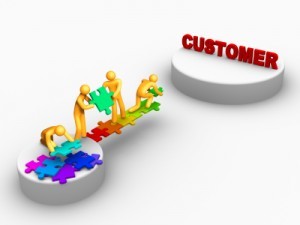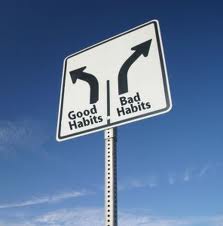 Have you ever interacted with a company that is clearly cutting back on customer service?
Have you ever interacted with a company that is clearly cutting back on customer service?
This can be a miserably inefficient experience, rife with unexpected wait times and repetition of information.
Cheap customer service does not create positive experiences. Lean customer service, on the other hand, does.
In the arena of ultimate user experience management, where a negative outcome might involve death, Lean management excels. Speed is key here--and it should be in your Lean customer service organization. As an intellectual exercise, try viewing your customers as patients. How can you "heal" them more efficiently?
Poor data means inefficient service. For example, imagine that a customer service representative spends an hour trying to resolve an issue with one audio product, only to discover that the customer has accidentally read her the wrong model number. Similar waste happens daily in most organizations.
Consider options that permit instant data gathering. If you operate a brick and mortar store or service center, you may wish to offer customers a loyalty card that records their purchasing history. If you use e-commerce, task your Web development team with installing a ticketing system that permits detailed notes on every account and ticket. Options like GetSatisfaction are both Lean-friendly and fairly affordable.
Long hold times as calls are transferred hurt your Net Promoter Score. These inefficient waiting periods are not compatible with Lean. Consider every call transfer a "movement," and eliminate unnecessary ones. For instance, do you really need to transfer your customer from sales to service simply to make an appointment? Why not give sales access to a user-friendly system that lets them book service calls?
Which of your customers spends the most of your employees' time on senseless service requests? Are they buying enough products and services to justify that level of attention? Consider jettisoning customers who present an extremely negative value proposition when revenue per customer is compared to the costs of service per customer.
Customers sometimes demand things to which they are not entitled; that much is, universal. Chances are, your employees adhere to policy when this occurs, leaning on responses like, "Sorry, but we cannot refund items purchased more than 30 days ago." Employees should support policy and avoid unnecessary expenditures, but are they spending more by arguing than they would by acquiescing?
Train employees to habitually evaluate the value of continuing a service call. If the amount in dispute is small, it may be wiser to say something like, "We do not accept returns past 30 days, but I am willing to make an exception and refund this item. Just promise me you will give us another chance the next time you need a part for your vehicle!" Then the ticket closes, your representative moves on, and the customer is happy.
 As a business, small or large, it’s important to make sure your customers don’t have a reason to shop around. Customers are an integral part a successful business. Without them we would not and could not exist.
As a business, small or large, it’s important to make sure your customers don’t have a reason to shop around. Customers are an integral part a successful business. Without them we would not and could not exist.
“If you think you can get away with sub-par customer service, logistics or any other function that affects your customer’s experience with your brand, think again,” says Steve Tobak, contributor to Inc.
Tobak provides common pitfalls every business should avoid.
There is no excuse when a business fails to deliver a product or service to a customer as promised. Failure to deliver on a promise is what effects customer perception most.
Fix: Always set expectations and deliver what you promise.
Customers don’t want to spend their day on the phone with you to figure out what is wrong and have the problem fixed. It’s a waste of their time.
Fix: Respect their time and keep communications short and sweet. Put a system in place to answer questions quickly and efficiently.
Some customers aren't pleasant and it’s not easy to deal with them. “You’d think companies could do better than having customer service people who are like crazed lunatics that went off their meds,” Tobak says.
Fix: Most people just want to get through the transaction and support in a speedy manner while being treated with respect.
Some companies don’t take feedback to heart and make it difficult to contact them directly. In the age of social media, it’s easy for customers to post negative feedback for the world to see.
Fix: Get regular feedback, encourage, and welcome suggestions about how you can improve. Listen to what they say and apply it to improve your business.
Sometimes the problems are caused by bad management and bad processes. “The most important thing I learned in quality training back in the 80s was that 90 percent of all problems are management problems,” says Tobak.
Fix: Treat your employees with the same respect you show your customers. Whether you have a large or small company, you can always improve your company culture. You just have to set the rules.
A customer complaint is a great opportunity to secure brand loyalty. One happy customer can create hundreds of potential new ones with a simple Facebook post. Customers demand a personal experience and they have a limited tolerance for mistakes so treat them that way.
What other customer service problems have you come across? How have you fixed them?
 Bully clients think if they push their weight around, they’ll get what they want. Sometimes it works because small businesses don't know how to handle them. But, when you let a customer bully you, you’ve lost their respect and set yourself up for a relationship of further abuse.
Bully clients think if they push their weight around, they’ll get what they want. Sometimes it works because small businesses don't know how to handle them. But, when you let a customer bully you, you’ve lost their respect and set yourself up for a relationship of further abuse.
“Unfair customers scream at airline, hospitality, and event personnel routinely,” says Baron Christopher Brown in an article on SmartBrief on Leadership. Bullies cross the line and bully your business model. “When their cash and time become desperate, some customers (clients, patrons, or members) can transact irrationally, even awfully.”
Bullying customers are dishonest and verbally abusive, but customers with high-expectations know what they want.
It’s important to know the difference because while bullies don’t pay well, high-expectations customers do. Plus, they are generally honest and civil.
“In my view, honest, courteous and well-paying customers are always right. Deceitful, manipulative fiscally bullying customers are always wrong,” says Brown.
So how do you deal with these bullies? Brown provides some advice.
Brown suggests business owners confront four transactional deficiencies:
What may entice a bully is a combination of perceived weaknesses of a business and evadable transaction policies.
“In my experience, chaotic, sloppy, unprofitable organizations routinely exude evidence of multiple transactional deficiencies simultaneously,” says Brown.
Once you've identified the deficiencies and established you aren't a punching bag, create new transaction strategies and proficiencies. Make sure you have a transactional policy and guidelines in place. Also, put legal, accounting, and business strategies in place.
Realize your strengths and ask yourself why you do things a certain way. If it’s because it’s always been done that way, it’s time to reassess the task at hand. You need to have concrete reasons for doing things a certain way. That makes it easier to say no to customers who try to pressure you to change your business.
A strategy isn't any good, and won't be successful if it’s not communicated to those who will implement it: Your employees. Train your front-line employees to maintain the boundaries you set.
When a company stands up for itself as a team, bully clients either disappear or change their ways. Confrontation isn't fun, but when you stand up to bullies, you make sure your business stays on course. Don't let your plans get pushed around by people who don’t have your best interests in mind.
Have you had an ongoing bully client? How did you handle it?
 Teaming up with the competition? It sounds counter-intuitive, since by definition any customer your competitor gains supposedly means a corresponding loss of revenue for you. Certainly this is an accepted truth in the “old school” business model.
Teaming up with the competition? It sounds counter-intuitive, since by definition any customer your competitor gains supposedly means a corresponding loss of revenue for you. Certainly this is an accepted truth in the “old school” business model.
But times are changing, says Erin Schwartz, a guest blogger on thoughtLEADERS LLC. In the modern business world, there are ways of working with the competition that can “actually enhance your business.”
What are the possible benefits of cooperating instead of competing?
When you and your competitor offer customers the same products or services, you’re both trapped in a “dog-eat-dog” business culture. The only way to win is by lowering prices, which Schwartz calls an “uninspired business model.”
A better alternative is specialization. Finding a way to differentiate your product can ultimately lead to enhanced business results “because you’ll have an easier time focusing and striving for improvement.”
The niche you develop may appeal to a smaller market, but in all likelihood you’ll have a lock on that market.
A willingness to refer customers to another business (if and when they’re in a better position to meet those customers’ needs) builds goodwill and respect among your customer base. “That respect will likely lead them back to you when they have needs that align with your specialty,” Schwartz notes. A like-minded competitor will return the favor and, upon occasion, refer people to you.
When you can establish a cooperative relationship with a competitor, many surprising things can happen. Sharing information can generate more effective and cost-efficient ways to do business and save money—always a win-win.
Your customers will benefit from improvements in products and services that come about as a result of positive intra-industry relationships. As Schwartz notes, “these improvements benefit the companies, which invariably find loyal customers through this process.”
He cites cases of business owners who pair up with similar companies to offer training and educational sessions on issues related to their businesses.
For example, two financial planners co-sponsor a seminar on retirement planning. One business owner focuses on which accounts to open to minimize tax burdens, while the other discusses long-term care insurance. In this case, it’s unlikely one financial planner took customers away from the other.
“Instead, they both gained exposure that they might not have received if they hadn’t worked together,” which can eventually lead to increased business for each one.
The global economy has forever changed the way we do business. The more competitors you have in your space, the more you can work as an industry to increase demand. With enlightened competitors, it’s possible to collaborate in ways that benefit your customers and enable your business to grow.
Wherever possible, look for ways to move beyond a “Me-Against-Them” business model and see how working with a competitor can benefit you both.
How can you work with a competitor to grow your business?
Thanks to Smallbusiness.co.uk for the image.
 Businesses get so caught up in the relentless pursuit of new customers, they often forget about the customers they already have. It’s a costly mistake, since by some estimates, acquiring new customers costs five to 10 times as much as keeping loyal customers. And no business survives long using that arithmetic.
Businesses get so caught up in the relentless pursuit of new customers, they often forget about the customers they already have. It’s a costly mistake, since by some estimates, acquiring new customers costs five to 10 times as much as keeping loyal customers. And no business survives long using that arithmetic.
Jason Brick, a contributor to Open Forum, warns “preventable losses” are the most damaging to small businesses.
He shares some tips about common mistakes all businesses make—and how you can avoid losing a customer.
“Sharing customer information can represent a new income stream for your business,” Brick concedes, but at what cost? When customers purchase your product or service, they are willing to share personal data with you. They trust you to be responsible caretakers of that data. Once trust is broken, you’ve lost a customer.
Politics and religion are hot-button topics under the best of circumstances, so there’s no good reason to unleash these “conversational time bombs” within the confines of your business.
“If a client brings the topic up, it’s best to be noncommittal while listening politely,” says Brick. Good advice!
Some businesses will go to great lengths to avoid owning up to their mistakes. Some even cast blame on their customers (“used our product incorrectly,” etc.).
Even if the issue is the customer’s fault, the wisest approach is to offer a sincere apology. As Brick notes, “The price of replacing a purchase or giving away a few hours of service is nothing compared to the future value of that customer.”
Amazon offers suggestions based on the products a customer buys, so why can’t you? “Firing off a set of suggestions without regard for who you’re asking shows you don’t value the customer as an individual,” Brick says.
On the other hand, if you take time to make suggestions based on a specific customer analysis, you may be providing genuine value to your customers. One-size-fits-all doesn’t work here.
Rudeness to customers takes many forms: inattention, loss of temper, acting bored or arrogant. It can happen to the best of us, but if it occurs in the course of a customer encounter, you will likely never see that customer again.
“Train your employees—and yourself—to leave those behaviors behind when they come to work,” Brick says. “Nothing you wouldn’t say or do to your favorite grandmother has a place when working with customers.”
Time and again, it’s the little things that count. How much effort does it take to acknowledge customers you’ve served before? Some small notice of their repeat business helps keep them loyal. As Brick suggests, “A ‘how did you like that shirt you bought last week?’ can go a long way."
Take a few minutes to remind your team of the value of honoring loyal customers who continue to purchase your products or services.
What are your own customer-retention best practices?
 At some point in the lifecycle of any small business, you’ll have to fire a customer. While it seems completely counterproductive to positive cash flow and business growth, there are times when ending a customer relationship is necessary.
At some point in the lifecycle of any small business, you’ll have to fire a customer. While it seems completely counterproductive to positive cash flow and business growth, there are times when ending a customer relationship is necessary.
In this post on OpenForum.com, James O’ Brien, author of The Indie Writer’s Survival Guide, explains when it’s appropriate to terminate a customer relationship for the best interest of your business.
“Owning a small business doesn’t mean continually trying to serve someone who’s shown they can’t be pleased. And that old business slogan — the customer is always right — well, that’s only accurate some of the time.”
Customer service representatives have to deal with some particularly unsavory customers, so empower your personnel to end abusive, vitriol-filled conversations quickly. It’s unreasonable to subject your service team to customers who, despite all attempts to resolve an issue, continue to use abusive language or threaten.
“Set out the rules of interaction with the problematic customer one last time, and make it clear that the next incident will result in you terminating transactions once and for all.”
Professional service companies feel the brunt of clients who place demands and expectations on them without providing the necessary resources to complete the project satisfactorily.
“For instance, you can’t make someone’s website copy sing if you can’t get access to the information the customer wants you include, and you can’t start pouring concrete until your client signs off on the blueprints.”
At some point, service providers can continue working with complaint-prone customers, but it’s another matter entirely to work with customers who delay completion of a project because they don’t deliver necessary materials on schedule.
Too many calls per day, constant changes to project timelines, and a lack of respect for other client needs are all signs of a customer unable or unwilling to respect boundaries.
Sudden schedule changes are particularly disruptive to busy workloads. If a client refuses to recognize their actions negatively impact timely and satisfactory delivery of their project, business owners need to take action and place that client in the care of another service provider.
“In the end, you’ll fire less and invoice more.”
While firing a customer is never a pleasant experience, it can be an opportunity to improve your internal processes on customer service, and taking on new work.
“Ask better questions about workflow and deliverables, and where you’ll get the data and materials necessary to complete the work.”

Autumn is upon us and soon we will be settling into winter for the next six months...at least here in Chicago.
It is also the time when you start planning for the next year, and the best way to do that is by thinking how you can create structure and stability for you team in the following year.
Think small. Even if you are leading a multi-million (or billion) dollar company, you have the opportunity to think small. Consider adding lead management practices to your organization in order to be flexible, nimble, and innovative going into next year.
Find the new opportunities. Your prospects are looking for more value for the money they are spending. Use tools such as Twitter search and Talkwalker Alerts to discover what is being said about your competition in order to find a way in to meet their customers.
Be aware of the risk. Pay attention to what your customers are saying about you, publicly, and be aware they could be looking for other partners. Use tools such as LinkedIn Groups to help customers and prospects with their issues, challenges, and concerns before they are ready to fire you. Open up communication, really listen to their concerns, and make immediate and public changes.
Become more customer aware. You may have the best customer service program in the world. That doesn't mean it can't change. Are you using the social networks to allow customers another way to connect with you? What about the chat feature on your website? Perhaps you have a strong email marketing program or a blog. Use these tools to give customers a voice to reach you.
How do you plan to create structure and stability for your team in the following year?
 Satisfied customers are a great thing. What’s even better are satisfied customers who feel compelled to tell others about your great brand.
Satisfied customers are a great thing. What’s even better are satisfied customers who feel compelled to tell others about your great brand.
The challenge is finding ways to motivate those customers to go out of their way to promote your business.So says Ekaterina Walter, CMO of digital media company BRANDERATI, and a contributor to Entrepreneur.
Walter offers several valuable tips on how to convert happy customers into “raving” brand advocates.
“Your in-store purchase receipts are a guaranteed point-of-contact with most satisfied customers,” Walter notes. Why not ask for customer feedback by printing details of your online survey at the bottom of the receipt - along with details about a prize customers might win by responding?
Don’t stop there, Walter says. “Make the survey social” by linking to Facebook, Twitter, Google+ and other social media sites. This way, customers can share the experience of entering your promotions with their friends and followers. (more…)
 Your business's Net Promoter Score is a critical measure of success.
Your business's Net Promoter Score is a critical measure of success.
Lean managers should place extra value on this metric, which gauges an organization's performance in identifying customer value points and eliminating waste.
Product quality is paramount, but customer service experiences also significantly affect your Net Promoter Score.
If your business's score is suffering due to negative and neutral service experiences, these five simple strategies may make a big difference.
Customers often report poor experiences because they are willing to give you a second chance.
Establish a policy of surprising and delighting your unhappy customers in order to convert them into Promoters.
Customers feel good about themselves when they believe they have helped a company improve. Solve their problems, surprise them with a free item or extra discount, and thank them sincerely for their help. (more…)
